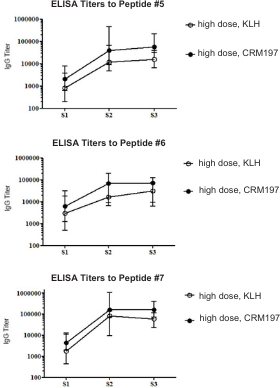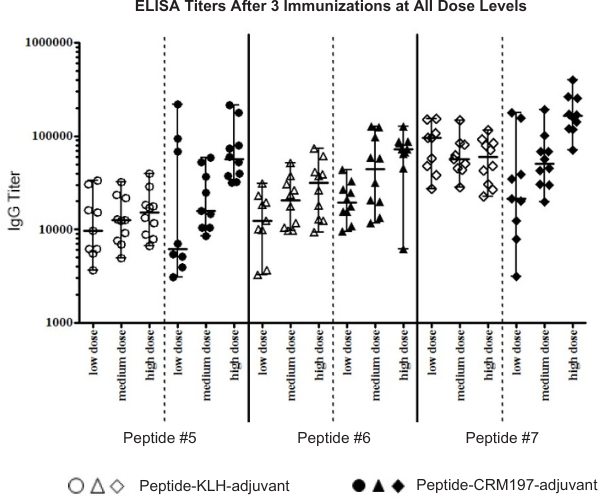Comparable Immunogenicity Observed in Peptides Coupled to PeliCRM197 and KLH in a Murine Model

Background
In this case study, 3 peptides (peptides #5, #6, and #7) directed to one therapeutic target were conjugated to either CRM197 (a non-toxic diphtheria toxin mutant) produced with Pfenex Expression Technology® or to KLH (keyhole limpet hemocyanin).
To allow comparison of the immunogenicity of the resulting formulation, 3 different doses of each formulation were injected (low dose, medium dose, high dose). Three immunizations were given to female BALB/c mice in two-week intervals via the subcutaneous route. Serum was then collected 2 weeks after each injection and antibody titers were determined by ELISA.

Focus of Analysis:
– Magnitude of immune response (antibody titers after 3 immunizations)

Vaccine Design:
Peptides with ≥95% purity were used. Peptide-CRM197-conjugates and peptide-KLH-conjugates were prepared using the same linker. Conjugates were adsorbed to an adjuvant.
ELISA titers to injected peptides after 1 (S1), 2 (S2), and 3 (S3) immunizations with the highest dose, median with range, n=10 are shown below, left.
Titers to injected peptides at S3 (single sera, n = 10) are shown below as median with range. Immunogenicity, in terms of kinetics and magnitude of CRM197, was evaluated based on three different peptides directed toward a single therapeutic target. Although differences were observed for some doses and peptides, the overall immunogenicity and kinetics of the immune responses were comparable between peptide-KLH and peptide-CRM197 conjugate vaccines in the tested animal model. This experiment provided the data necessary to support the substitution of KLH with Primrose’s cGMP CRM197 in future clinical studies of this vaccine.